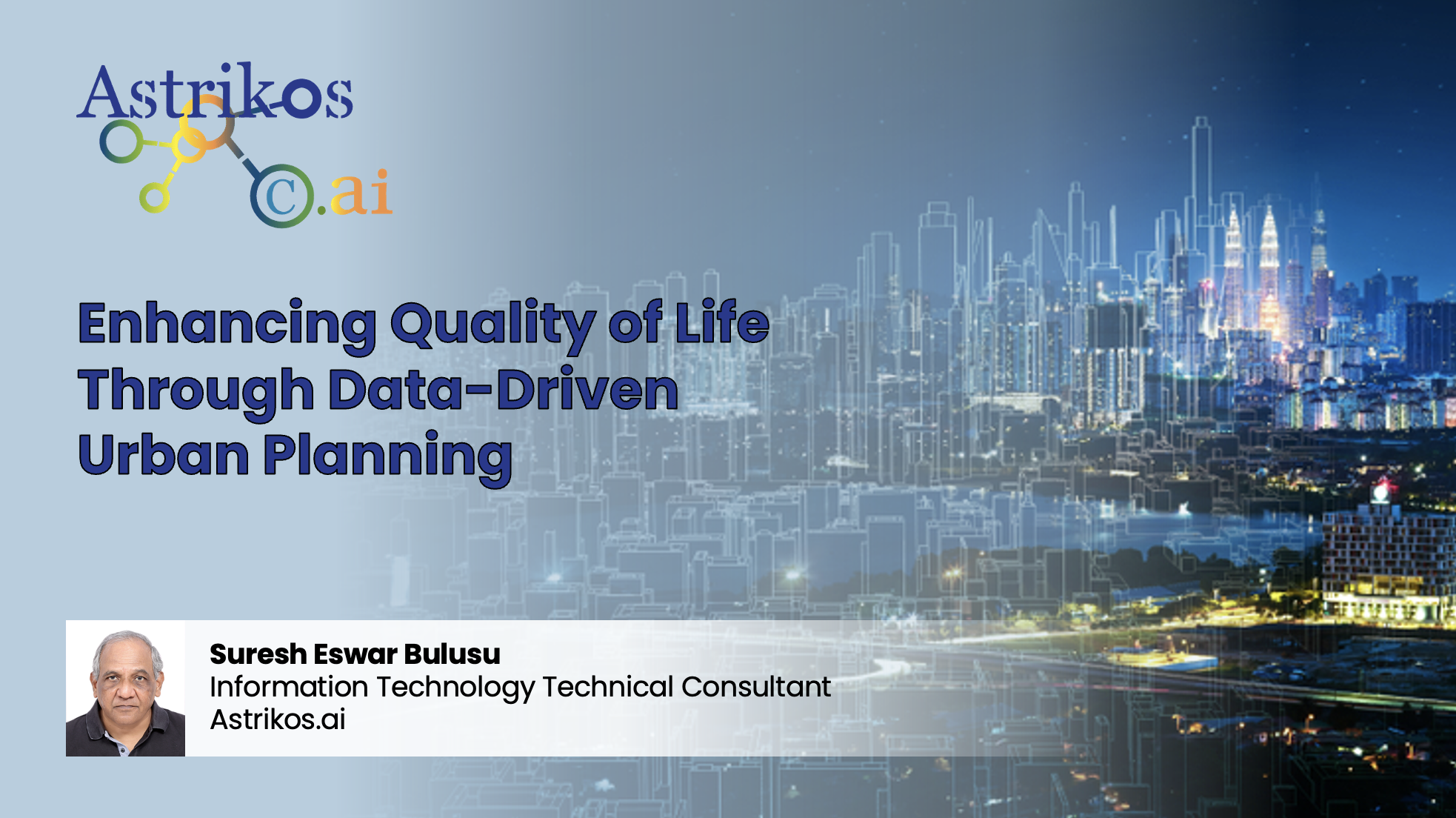Enhancing Quality of Life Through Data-Driven Urban Planning - Suresh Eswar Bulusu, Information Technology Technical Consultant, Astrikos.ai

Traditional
urban planning has undeniably played a crucial role in developing cities
worldwide, providing a time-tested foundation for urban growth. However, this
approach has significant shortcomings. It has often prioritized corporations
and automobiles over the basic needs of city residents, resulting in
environments that fail to address the quality of life and well-being of those
living there. The focus has been more on economic growth than long-term
sustainability, often neglecting social and ecological considerations.
This type of planning has always been done in silos, addressing issues in isolation rather than through a comprehensive, holistic approach. As a result, poorly designed urban environments have emerged, leading to overcrowded cities plagued by traffic congestion, insufficient affordable housing, and inadequate access to quality education and healthcare. These factors contribute to the growing challenges faced by economically disadvantaged populations, who struggle to improve their financial situation.
Moreover,
the high levels of traffic congestion, which aggravate air and noise pollution,
pose significant health risks, particularly for vulnerable groups such as the
elderly and children.
Lack
of Walking and Cycling Lanes
Many cities have been designed with a focus on private cars, even though the majority of the population relies on walking, cycling, and public transportation. As a result, these cities often feature wide roads and highways for vehicles, making it difficult for pedestrians to cross safely and comfortably. This lack of walkability presents a significant challenge to creating a truly livable city. With rising fuel prices making car ownership increasingly expensive, there is a growing emphasis on walkability. It is crucial to make walking and cycling safe and enjoyable, ensuring that pedestrians and cyclists feel welcome and valued in the urban environment.
Inadequate
Public Spaces
Traditional urban planning often results in the encroachment of public spaces by property developers, the proliferation of commercial complexes, and restrictive regulations from government agencies, all of which create challenges for the general public. Public spaces are crucial for fostering a sense of community, providing residents with areas to gather, socialize, and relax—yet these are often overlooked in conventional city planning. Additionally, traditional approaches frequently fail to prioritize the efficient use of space and the environmental impact, leading to unsustainable cities that contribute to climate change.
These challenges can be addressed by integrating data-driven analytics into urban planning, shifting the focus toward creating cities that are centered around the needs of their residents. This transition from inefficient traditional methods to a more dynamic and effective approach allows policymakers and urban planners to make informed decisions based on data.
Revolutionizing
Urban Planning with Data Analytics
Leveraging data and
advanced technologies, cities can be transformed into citizen-centric
environments where residents enjoy a higher quality of life, improved health,
efficient transportation systems, and vibrant public spaces. This approach
encourages walking, cycling, and the use of sustainable transportation options.
Urban planners can analyze data from diverse sources, including demographics,
traffic patterns, and utility usage, to identify trends across different areas.
This data-driven insight allows for precise resource allocation, better zoning,
and more effective long-term urban planning.
Affordable
Housing Solutions
As cities experience a surge in population due to ongoing migration, the demand for affordable housing continues to rise. Data-driven planning plays a crucial role in addressing this need by analyzing land use, population density, and trends in economic growth and sustainability. This approach helps identify optimal locations for developing affordable housing communities, fostering economic mobility, and reducing homelessness, ultimately improving the quality of life for residents. Moreover, policymakers and urban planners can use data analytics to anticipate future housing demands, proactively preventing shortages and ensuring that adequate housing options are available for all citizens.
Effective
Traffic and Transportation Management
Data analytics plays a pivotal role in optimizing and managing urban traffic and transportation systems. By collecting real-time data from GPS devices and sensors, cities can analyze traffic patterns to reduce congestion, optimize traffic signals, and enhance transportation routes. This data-driven approach allows for the development of more efficient public transportation systems that align with population growth patterns and commuting demands. Additionally, data analytics can assist in planning new routes and schedules, as well as expanding existing ones, to better serve residents. Looking ahead, intelligent transportation systems can be developed to adapt to ever-changing traffic conditions, ensuring reliable and efficient transit options that meet the needs of the community
Health
and Public Safety
Big data analytics can greatly enhance emergency response services by analyzing data on health incidents and response times, leading to faster and more effective interventions. By examining crime rates and identifying high-risk areas, data can guide the efficient allocation of resources and help develop targeted public safety measures. Safer neighborhoods also facilitate quicker access to healthcare services. Additionally, understanding the demographics and behavior patterns of specific populations through data analysis enables urban planners to design parks and recreational facilities that meet the unique needs of each community.
Sustainability
Achieving sustainability is a key objective of modern urban planning. By leveraging insights from data collected through sensors and IoT devices, city planners can monitor air and water quality, manage noise pollution, and improve waste management, all of which contribute to a healthier urban environment. Data analysis also enables the development of strategies to reduce energy consumption and carbon footprints, while promoting the use of renewable resources. This data-driven approach is essential for building cities that are not only sustainable but also resilient in the face of environmental challenges.
While data offers
several benefits, urban planners and policymakers should ensure the ethical use
of data and maintain its security, privacy, and integration to gain and sustain
public trust. With cities growing
exponentially, a data-driven approach will create more livable, vibrant, and
sustainable urban environments.



